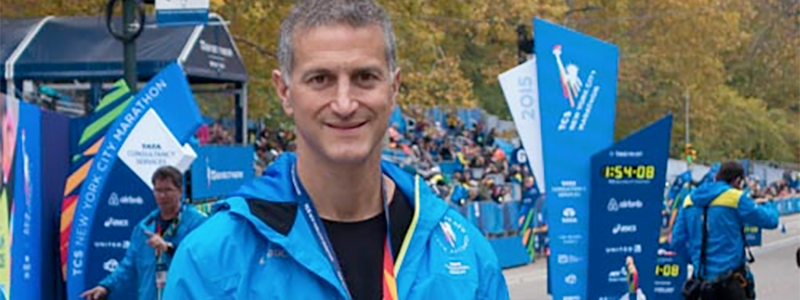- By Andrew L. Rosen, MD
Dashing Whippets Wellness Partner, orthopaedic surgeon Andrew Rosen, MD, FAAOS, gives some valuable advice about knee problems. He writes that finding sustainable, long-term solutions will yield far superior results compared to simply buying a knee brace.
Line up at any running race and you will see many participants wearing all manner of contraptions on their knees, including braces, straps, and funny-looking, colorful tape. Although these devices may play some part in alleviating knee pain, many runners neglect to fix the underlying problem that has forced them to seek help in the first place.
I often tell patients that running doesn’t typically cause knee pain because of trauma to the body, but because of pre-existing muscular imbalances that are amplified by the repetitive forces of running. When running on regular basis, these imbalances may lead to pain in the leg. And although some knee problems are indeed structural (cartilage tears, arthritis, stress fractures), most basic knee pain is muscular in nature.
The two muscular imbalances that typically affect a runner are a weakness of the inner portion of the quadriceps (the VMO) and tightness of the iliotibial band (outside of the thigh). Addressing these two issues can usually correct the patellar (kneecap) maltracking which occurs, and thus improve the symptoms. If left unaddressed, these imbalances may result in either one or both of the two most common running disorders: patellofemoral knee pain (Runner’s Knee) and iliotibial band syndrome.
Running is an inherently hamstring (back of the leg) muscular activity and, with increased training, often does not lead to strong, well-balanced quadriceps muscles. Of course, runners will have strong legs compared to a group that doesn’t run at all, but muscular development is often not well-balanced.
A simple program of strengthening the inner quadriceps and stretching the IT band is usually very effective in alleviating the symptoms and allowing a runner to perform pain-free. These exercises can be learned either through basic internet research or by scheduling a formal consultation with a physical therapist. Also, a good foam roller is a powerful tool that should be a part of a runner’s toolkit.
Although braces can be helpful in decreasing symptoms and are sometimes helpful in keeping a runner going, they are rarely the first (or only) treatment that is recommended. For many runners, the key to running pain-free is to do work outside of running. Knee mechanics are better improved ‘internally,’ by stretching and strengthening, and will usually resolve the underlying issues. A workout program that builds strong, well-balanced legs can be critical to keeping knees healthy during long-distance training.
Dr. Andrew Rosen is an orthopaedic surgeon and 2017 Wellness Partner to the Dashing Whippets Running Team. An accomplished runner himself, Dr. Rosen is a sports medicine specialist with special interest in treating endurance athletes. He treats all types of running injuries, as well as many other musculoskeletal problems including arthritis, overuse conditions and traumatic injuries. Dr. Rosen can be reached at:
 Andrew L. Rosen, M.D., FAAOS
Andrew L. Rosen, M.D., FAAOS
Upper East Orthopaedics
315 East 83rd Street
New York, NY 10028
(212) 986-9200

